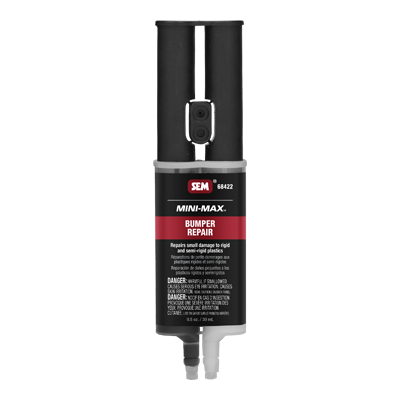Part 2 of the Givi Polypropylene saga.
At this point, I have attempted to sand the texture of the polypropylene cases down a bit before painting. The first attempt was made with Dawn dish detergent and 400 grit wet / dry sandpaper. I like sanding under water - the results are more consistent and there is no dust. The 400 grit, however, did not make a bite in the textured finish. So, I moved on to 220 grit, which produced slightly better results. Well, it knocked the contamination down enough, but most of the texture stayed.
One of the cases had some road rash on the lower corner I wanted to fix.
After cleaning it with SEM Plastic Prep solvent, I decided to try another SEM Product
Mini-Max Bumper Repair epoxy, which is made for Polypropylene. SEM suggests grinding the damaged area with 24 grit sandpaper. Not having any around, I used a wood rasp to create grooves in the damaged area, which was then wiped down with the Plastic Prep.
This epoxy mixes easily, and is very sticky right after mixing. Working time is about 5 minutes, so do not mix large batches. With a plastic putty knife, I applied the epoxy into the damaged area, making sure I would have a plenty of excess material to be able to sand it smooth. By the way, before the epoxy cures, it has a tendency to run a little - much like JB Weld.
Once cured, I knocked it down with the 220 paper and feathered the edges in.
The epoxy stays put in place, and cured is pretty flexible. I had some leftover on the putty knife, and even bending the edge did not crack or separate the epoxy from the knife. I'm very confident it will stay on the prepped polypropylene case.
Next step is one final wash before getting ready for primer.
A place to share passion for two wheels. Trips, adventures, dayrides, some farkles, and some projects where old machines get a new life.
About Me

- Henry Martin
- Henry Martin spends his nights writing fiction and poetry, which predominately deals with the often-overlooked aspects of humanity. He is the author of three novels: Escaping Barcelona, Finding Eivissa, and Eluding Reality; a short story collection, Coffee, Cigarettes, and Murderous Thoughts; and a poetry collection, The Silence Before Dawn. His most recent published project is a collection of Photostories in five volumes under the KSHM Project umbrella, for which he collaborated with Australian photographer Karl Strand, combining one of a kind images with short stories and vignettes. He is currently working on his next novel narrated in two opposing points of view. He lives with his family in the Northeast.
Subscribe to:
Post Comments (Atom)





No comments:
Post a Comment